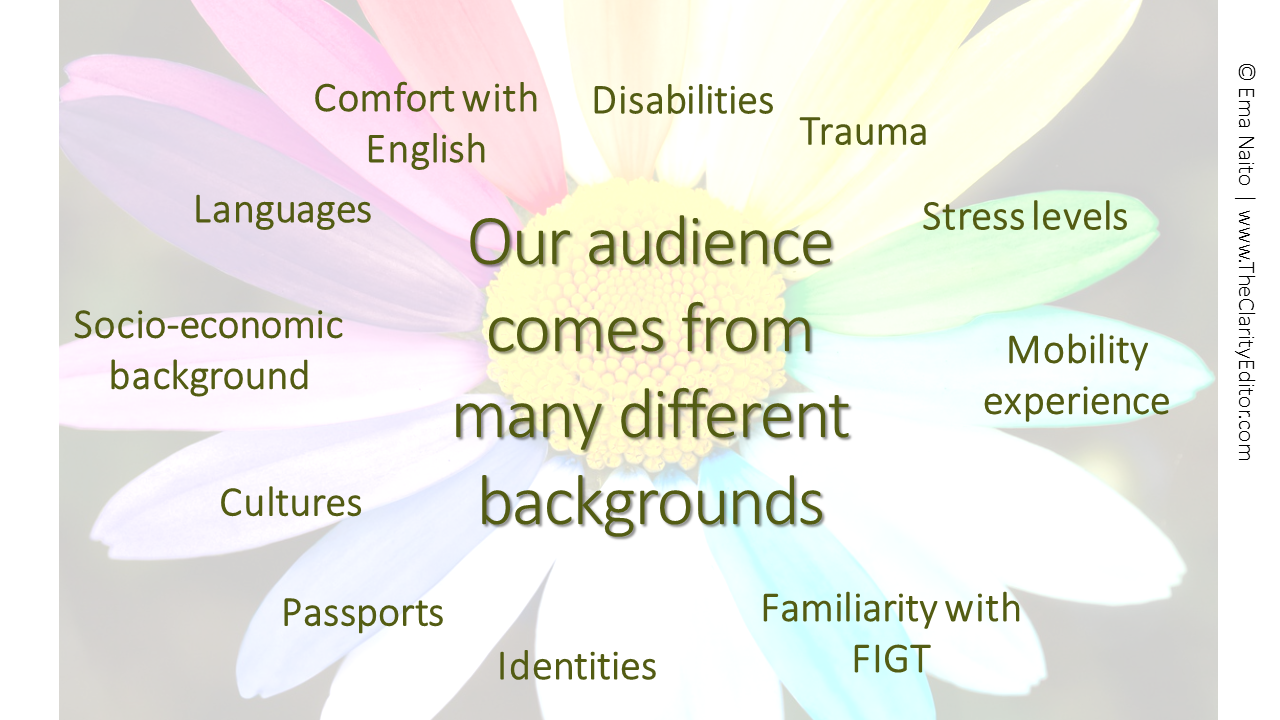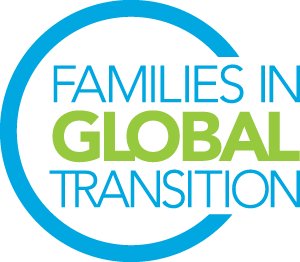In Part One of this two-part series, FIGT member Ema Naito shares how, with a few thoughtful choices, your written and spoken presentations can reach a greater audience.

By Ema Naito-Bhakdi
FIGT brings together globally mobile people. That means many of us have plenty of experience talking to people from different parts of the world.
Then why are we talking about how to use clear English at FIGT conferences?
It’s because FIGT wants everyone—that includes you!—to feel they can fully take part in FIGT activities and that they are valuable, contributing members of this community.
And using clear English is one of our tools to create that space.
(I loosely define clear English as English that is understandable and accessible to as many people as possible.)
And of course, clear English will also help us, FIGT2022 presenters, be trusted and understood by our audiences.
What’s in this article:
A reminder: Our audience is diverse
Without an audience, our presentations are nothing.
We all know that FIGT audiences are diverse, in cultures and religions, languages, passports, socioeconomic backgrounds, identities, and family structures, not to mention experiences of trauma, disabilities (physical and mental, temporary and permanent), and current stress levels.
All these affect how we understand and engage with the world around us.
But also remember that FIGT2022 audiences are diverse in experiences of mobility and familiarity with FIGT.
- We have different experiences of mobility. Some of us move countries every year; some haved lived abroad once. Some cross cultures daily through family, school, or work. Some choose to move; some are forced. All different.
- We have different levels of familiarity with FIGT. Our organization is remarkable that members stay for decades, but we also welcome many new faces each year. Remember that the words and ideas we casually use (e.g., “TCK”) may be new to many.

Tips for presenting & speaking
So! Here are some things to keep in mind to more effectively communicate with our FIGT audience.
1. Be aware of your word choice
Avoid slang, figures of speech, cultural references
In slang and figures of speech, the literal meaning of the words do not match the intended meaning.
“I chickened out” (got scared and didn’t do something).
“It’s so whitebread” (plain).
“He wears his heart on his sleeve” (shows his intimate emotions honestly).
(Can you find all 27 English figures of speech in this drawing by graphic artist Ella Baron?)
Also watch out for cultural references, like referring to TV and film, sports, fashion trends, celebrities, and music.
These can make it difficult for people to understand what you are trying to say.
They also are often used to signal that we’re members of the same group—but if we don’t understand the reference, we feel left out.
Avoid jargon & acronyms – if you must use them, EXPLAIN
This one is especially important for our researchers and specialists! We can get so used to using certain words that we forget: not everyone knows what those words mean.
For example, post-colonialism, translanguaging, TCK.
Try to use as few of those special words as possible.
If you must use technical words, have the courtesy to explain them the first time you mention them.
Offer a simple definition. Formal definitions can often be too technical, so choose something that will let your audience easily understand and remember the concept.
And remind people what those words mean from time to time.
2. Use short “plain” words
Don’t try to sound “sophisticated.” Use the shorter words.

See “The A to Z of alternative words”, Plain English Campaign, for more.
3. Find the action: Find the verb
Often, we “smother” (hide) the action as nouns. But actions are more interesting and engaging, human.
So rescue those verbs!

If you can put the “I” and the “you” back into the sentence, then that’s even better.
4. Speak slowly
Remember to speak slowly! Practice and time yourself.
Speaking slowly will give the audience a chance to understand what you are saying. If you go too fast, more people will get lost or overwhelmed.
Also, don’t be afraid of pauses. They can give precious space for the audience to think, feel, process what you’re sharing.
Summary
So! To sum up:
When speaking
Choose your words
- Avoid slang
- Avoid jargon & abbreviations – but if you must use them, explain the word first
- Use plain words
Focus on action
- Use active verbs (rescue the actions from the nouns)
Speak SLOWLY!
Resources
There are many great resources out there on all the points above.
Plain language
Accessibility
Design basics
Presentations
* Many thanks to Sarah Black, Athru Communications, for the accessibility & inclusion resources.
Find Part 2 of this article, here.


Ema Naito is an English editor who is passionate about clear, plain language. A bilingual third culture kid, Ema grew up between Tokyo and the US East Coast. She now lives in Bangkok, is an FIGT volunteer, and will be hosting a Kitchen Table Conversation at FIGT2022. You can find more of her tips on clear and accessible writing at www.TheClarityEditor.com.

